This article will prepare you for an epic southern Utah road trip, one of the most fascinating landscapes on the planet. I lived in the desert Southwest for a few years and explored this incredible region up and down.
What makes southern Utah so special? You’ll find out in this post, but it’s really the openness of the land and beauty of the colorful rock formations that form the desert floor. Barely anyone actually lives there, a testament to the harshness of the desert.
Sandstone rocks of all shapes and sizes dominate the landscape and there are more canyons than humans in some parts. So buckle up and hit the road for one of the best road trips the USA has to offer!
- Why Should I Listen to You?
- The Main Sites You Will Hit
- Southern Utah Road Trip – The Basics
- The Perfect Southern Utah Desert Road Trip
- Day 1: Las Vegas to Bryce Canyon National Park
- Day 2: Bryce Canyon to Capitol Reef National Park
- Day 3: Capitol Reef to Moab
- Day 4: Arches National Park
- Day 5: Canyonlands National Park
- Day 6: Moab to Monument Valley
- Day 7: Monument Valley to Page, AZ
- Day 8: Page to Zion National Park
- Day 9: Zion National Park
- Day 10: Zion to Las Vegas
- Day 1: Las Vegas to Bryce Canyon National Park
- Southern Utah Road Trip: FAQs
- Southern Utah Road Trip: The End
Note: this article contains affiliate links, which means that should you purchase something or get a quote through them I may make a small commission at no additional cost to you. This helps keep the site running with up to date information. I do not represent GetYourGuide, Insubuy, Booking.com, or Rentalcars.com. This is information only and not a recommendation to buy the product mentioned in this article.
Why Should I Listen to You?
Anybody can write anything these days. Especially with travel blogs, where you can be an “expert” in something after one visit. But I lived in Las Vegas and extensively explored the desert southwest, so you can be sure you’re getting tips from a local.
While I no longer live in Vegas, my experiences during my time there led me to fall in love with southern Utah. I’ve been to all seven continents, over 60 countries, and southern Utah still remains one of my favorite places on earth. You will fall in love with it too after this road trip!
The Main Sites You Will Hit
We will go through all the sites in detail in the itinerary below but let’s start with an outline of all the amazing places you’re going to see. On top of Utah’s 5 incredible national parks, you’ll be exploring some state parks and other landmarks. You’ll also dip into Arizona for a bit to see some of the most Instagrammable places in the US.
National Parks:
- Zion
- Bryce Canyon
- Capitol Reef
- Arches
- Canyonlands
- Glen Canyon National Recreation Area
State Parks:
- Dead Horse
- Goosenecks
- Valley of Fire (NV)
Other main attractions:
- Monument Valley
- Valley of the Gods
- Antelope Canyon
- Horseshoe Bend (part of Glen Canyon National Recreation Area)
Southern Utah Road Trip – The Basics
This road trip assumes you will start and end in fabulous Las Vegas, Nevada. Las Vegas is the gateway to the southwest and has some amazing natural wonders in its immediate vicinity. You could also start from Salt Lake City, UT or Flagstaff, AZ with a little extra driving.
To car of campervan? That is the question!
You will need your own vehicle for this road trip. It’s very easy to do the trip in a normal, 2-wheel-drive car. However, if you want to do some of the more difficult unpaved roads in Canyonlands or some of the other places you’ll need a 4×4. That being said, there’s really not a lot of time for off-road driving in this itinerary so a regular car is just fine.
You can find the best deals on rental cars from Las Vegas here at rentalcars.com.
You can also rent a campervan from one of the many providers in Las Vegas that cater to travelers like you. Most of Utah allows freedom camping, meaning you can park really anywhere that is off the road and spend the night. So it’s a great place to drive a campervan around. The developed campsites in the national and state parks have excellent services though, so car camping is fairly easy.
The landscape of southern Utah
Southern Utah and Northern Arizona are classified as high desert. This means that you’re in the desert, but the elevation is actually pretty high. Most of this trip you’ll be over 4000 feet and you’ll get above 8000 in some places.
The landscape is barren and inhospitable. Red sandstone rocks are everywhere and vegetation is few and far between. The earth cracks here and there forming giant canyons every way you look, and distant snow-capped mountains form the background of many of your views.
It’s quite unlike anything else on earth. Not even Petra in Jordan or the Australian Outback can quite compare.

Total mileage covered on the road trip
This road trip covers about 1200 miles and takes 20 hours over the course of 10 days. But that doesn’t count any side trips or any driving around the parks themselves. All in all plan on spending an average of about 2-3 hours a day in the car.
Cost of the road trip
How much does this southern Utah road trip cost? Well that’s entirely up to you and depends on where you want to stay and where you live. If you’re from Southern California you can avoid the flight to Vegas and the rental car by adding a few hundred miles to your road trip. If you’re from New York you’ve gotta fly and rent a car.
This trip can also be really, really cheap if you camp instead of staying in hotels. Standard tent campsites at national and state parks in Utah will run you $20-$30 per night.
Want to stay in a hotel? Good luck finding something less than $200/night outside the national parks. And I mean like a La Quinta will cost you $200. If you want to stay somewhere nice, well, I hope you have a good job and make good money.
Airbnb has some options between these two extremes. If you’re looking for more like $100/night Airbnb can be a good option in Utah.
Best time of year for a southern Utah road trip
You will ideally want to make this road trip in either spring or fall. Summer is possible, but southern Utah can get pretty damn hot in the summer and that can make camping uncomfortable.
Winter is also possible – and hotels will be much cheaper – but it can get pretty cold in the high desert in the middle of winter. Spring and fall offer great weather, long days (spring better than fall for that), and ideal conditions all around.
National Park Pass
You will want the America the Beautiful Interagency Pass for this trip. This pass is more commonly known as the “national park pass” and gets you into any national park, monument, historical site, etc in the US for one year.
The pass, amazingly, still costs only $80 and seems to be inflation-proof. It’s been $80 since the 2000s (and for senior citizens it’s free!). The pass will pay for itself after visiting just three of the five national parks on this itinerary.
The national park pass will not get you into state parks or parks on Navajo Nation land (i.e. Antelope Canyon and Monument Valley Tribal Park). Be sure to order it well over a month in advance of your trip, as it can take a while to arrive in the mail.
Popularity and crowds
Make no mistake, the national parks in Utah are incredibly popular with Americans and international tourists alike. Zion and Arches are two of the most visited parks in the US, and you can reasonably expect to encounter massive crowds unless you go in the winter. If you plan on camping within the parks, you will have to reserve campsites months – possibly even up to a year – in advance.
Of the parks you’ll visit, only Arches requires timed entry permits. This means you have to pre-book entry into the park and is done to control crowds and traffic. But there can still be major backups to get into the other parks.
Capitol Reef is the anomaly, being much less visited than the other four. Outside the national parks, you probably won’t encounter too many crowds, though the other destinations on this itinerary are becoming more and more popular these days.
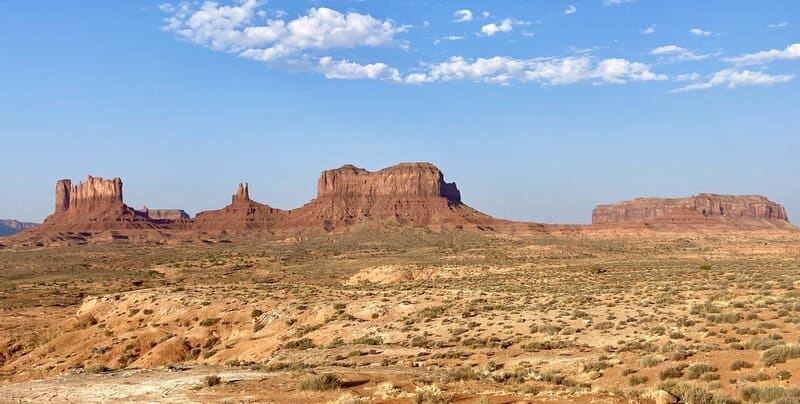
Where to stay
As mentioned before, the cost of the trip varies greatly on whether you plan on camping or staying in hotels. If you do plan on camping, it’s best to download the Campendium app. It has every campsite in Utah mapped and tells you what type of campsite it is.
On top of the campsites in the national parks, there are tons of privately run campsites all over Utah as well as basic campsites in national forests. It even will tell you all the locations of dispersed camping, which is essentially just a flat area with no services that it’s free to camp. The app is vital for this road trip if you’re going to camp.
If you’re staying in hotels there are quite a lot of options in Moab, Springdale, and Page, AZ but far less options between these main towns. You will want to book hotels in advance, but you don’t need to book months out like a national park campground. Each day of the itinerary below has detailed recommendations for hotels each night.
Travel insurance
Americans, you can skip this section. But if you are an international visitor it is vital that you have travel insurance for your trip to the States. The insurance must cover medical expenses.
If you don’t have medical insurance for your trip, you are putting yourself at risk of great financial consequences should you suffer an accident or have a medical emergency. We don’t have universal healthcare here in the US and an overnight hospital stay can easily cost $100,000 that you probably don’t have.
Insubuy provides medical travel insurance for international visitors to the US. You can get a quote for travel insurance and book your coverage using the link below.
Get a great deal on travel insurance for the USA here.
The Perfect Southern Utah Desert Road Trip
Without further ado let’s get into it! You can see a visual of the southern Utah road trip itinerary in the Google Maps view below to follow along with the text.
Day 1: Las Vegas to Bryce Canyon National Park
After an epic buffet breakfast at your Las Vegas hotel, it’s time to say goodbye to that hangover and hit the road. It’s about a four hour drive to Bryce Canyon National Park. Most of the 260 miles are on I-15, so you’ll be moving quickly today. Though once you exit just after Parowan, UT, you’ll wave goodbye to interstate highways. Other than a brief stint near Moab, you won’t see one again till you’re almost back to Las Vegas.
Bryce Canyon National Park is one of the most unique landscapes in the world. Sharp columns of red sandstone rocks – known as “hoodoos” – protrude from the earth like giant needles as the canyon descends from the cliff above.
Bryce Canyon itself is quite small, and if you arrive early in the afternoon you’ll have plenty of time for a hike down into the canyon to admire the hoodoos up close. But first, start with a short stop at the Visitor’s Center to learn a little more about the crazy geology of the area.

There are a few observation points along the canyon rim that are connected by a series of roads. Start by hitting all the viewpoints to find your favorite view of the canyon. When you’re satisfied with the incredible views, it’s time to hike into the canyon.
Park at the end of Sunrise Point Road and embark on a leisurely hike down into the canyons known as the Wall Street and Queen’s Garden Loop Trail. The hike is only a little more than 3 miles, but you’ll stop so many times to admire the hoodoos that it will take a while.
End your day with dinner in the nearby village of Bryce to celebrate a great first day of the road trip.
Where to stay in Bryce
Camping: There are two campgrounds within the park, North Campground and Sunset Campground. North requires reservations from May 19 – Oct 7 and Sunset is always first come first served, but closed in winter. Tent sites are $20 per night per site.
Mid Range: There are not a lot of options for hotels outside the park that are not expensive and not downright awful at the same time. Consider the Best Western PLUS Ruby’s Inn or Bryce Canyon Pines.
High End: For the most comfortable stay, opt for a room at the Lodge at Bryce Canyon in the park. Don’t expect to find a room for under $300 though. Book well in advance.

Day 2: Bryce Canyon to Capitol Reef National Park
If you’re not too tired, wake up for sunrise over Bryce Canyon. Head back to the same sunrise viewpoint you were at yesterday and bask in the beauty. If you’re up for a morning hike, head into the canyon again to catch the morning sun on the hoodoos.
It’s about a 2.5 hour drive on Utah’s back roads to Capitol Reef National Park with no stops, so allow about 3 hours. Plan to arrive in time for lunch at the Wild Rabbit Cafe just before the entrance to the park.
Capitol Reef is by far the least visited of Utah’s five national parks. But while it doesn’t hold the same grandeur as the others, it’s still a beautiful region of red sandstone mountains and desolate canyons. If you’ve been to Petra in Jordan, the rock formations are pretty similar, just without the ancient Nabatean buildings carved into the cliffsides.
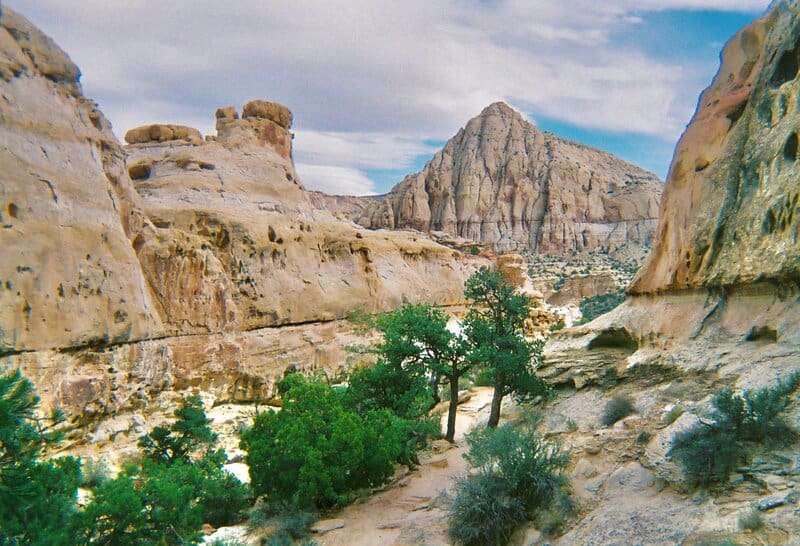
There is one scenic drive in the park and it takes you about 10 miles off the main road to the south. It ends at Capital Gorge trailhead, the start of one of the most popular hikes in the park. It’s an easy walk through a gorge so plan on doing the full out and back Capitol Gorge hike in the afternoon. The rocks will help protect you from that desert sun if it’s a hot day.
If you have time and you’re up for it you can also do the short Cassidy Arch trail on your way back to the main road. After catching the sunset, enjoy a relaxing night in one of the most underrated places in Utah.
Where to stay at Capitol Reef
Camping: The Fruita campground in the park has 71 sites. The sites are $25/night and must be reserved in advance.
Mid Range: The nearby town of Torrey has a few lodging options. The Broken Spur is your best bet for affordability if you want a bed to sleep in.
High End: Cougar Ridge is where you want to stay if you’re looking for a little luxury.
Day 3: Capitol Reef to Moab
Take it easy this morning and sleep in. Take your time packing up and hit the road for Moab, Utah’s desert playground. It’s another 2.5 hours drive to Moab.
Spend the afternoon exploring the little city of Moab, which is full of shops where you can buy local arts and crafts. As much as you’re itching to get to Arches, don’t even bother in the middle of the afternoon. It will just be too crowded.
If you want an afternoon adventure consider a river rafting tour with Moab Adventure Center. If not, take it easy and check into your hotel or campground.
As evening sets in, the day trippers to Arches leave. This is when you’ll enter. Between April and October Arches requires timed entry passes – since it can get so ridiculously busy – but those are only required between 7 AM and 4 PM. Following this plan here, you won’t need to get a timed entry pass, as you’ll enter after 4 PM today and before 7 AM tomorrow.
Depending on what time of year it is and when sunset is, you might want to grab dinner in the city first. Make sure to get to the park at least an hour before sunset. Golden Hour in Arches National Park is simply stunning.
The rocks appear shades of orange and red that you didn’t even know existed. Watch the sunset over this magical landscape of giant rock bridges, but don’t stay up too late, because you have an early morning tomorrow.
Set your alarm for 2 hours before sunrise – yes that’s right 2 hours before sunrise. If you’re visiting in June that’s 4 AM. So better get to bed.
Where to stay in Moab
Camping: There are literally dozens of independent campsites in and around Moab. There is one campground in Arches National Park and two small campgrounds in Canyonlands. All sites require reservations, however for the campsites outside the parks it’s possible to just show up and book something.
Mid Range: There are many options in Moab for motels and mid-range hotels, like the Red Stone Inn.
High End: At the north end of town you’ll find the Springhill Suites by Marriott and the Hyatt Place Moab. I stayed at the Hyatt Place on my most recent trip to Moab and had a lovely stay.
Day 4: Arches National Park
You’ll awake well before the crack of dawn for one reason and that is to be the first person at Delicate Arch, the most iconic landmark in the park and one of the most iconic places in the United States.
The Delicate Arch Trail parking lot is about a 30-minute drive from central Moab. Get to the parking lot no later than one hour before sunrise. It will be dark and you’ll need a headlamp or a flashlight for the hike. The Delicate Arch hike itself is pretty relaxed, about 1.6 miles with a mild elevation gain. It should take no more than 45 minutes but a half hour or so if you’re fit.

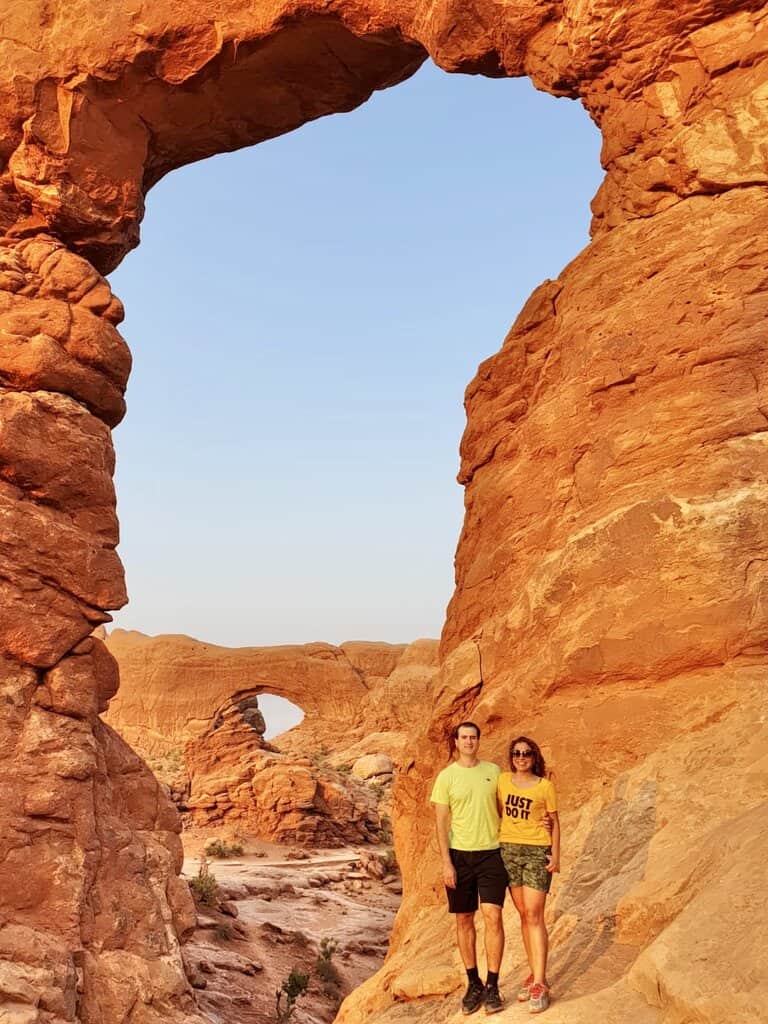
You’ll arrive at Delicate Arch right as the sky starts to get light. Relax and watch the sunrise over the arch, one of the highlights of your trip! Just note that to get the famous photo under Delicate Arch, you will have to wait in line.
Spend the rest of the day exploring Arches National Park. There are many other trails to hike and viewpoints to observe. It’s one of America’s treasures and you’ll want to soak up every last bit of it that you can.
Spend the night in Moab again. If you like Thai food, be sure to check out Arches Thai just off the main road.
Day 5: Canyonlands National Park
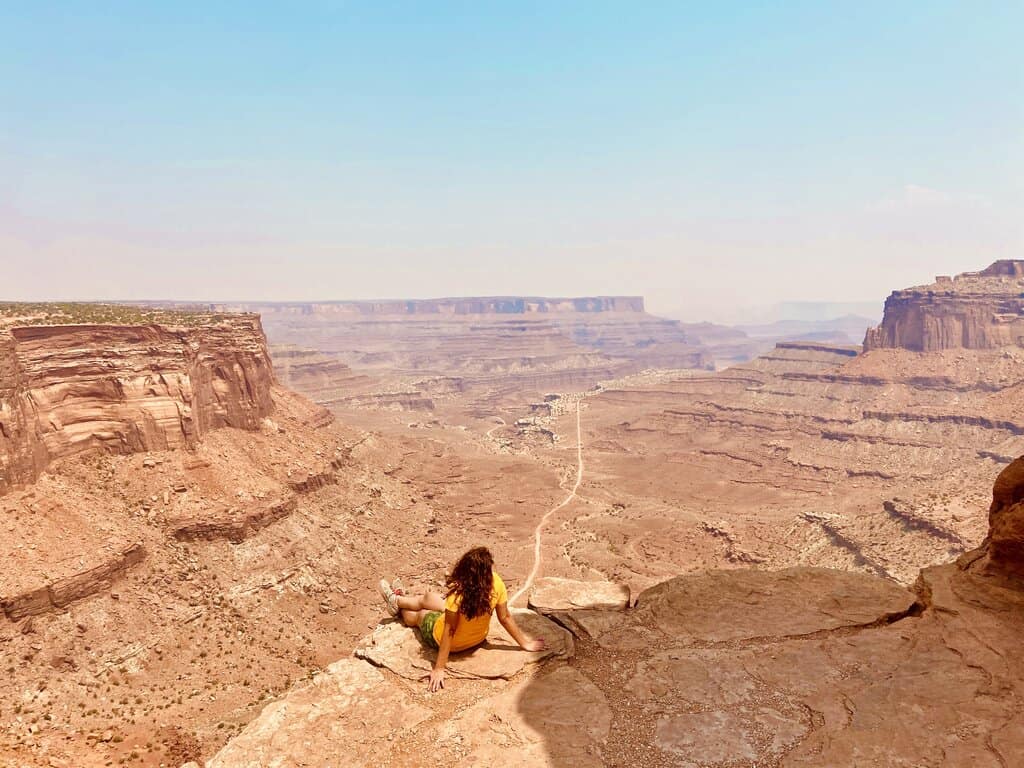
Today is for canyons. Start the morning by driving about 45 minutes into the northern unit of Canyonlands National Park (there are three separate sections of the park), known as Island in the Sky.
Canyonlands is mostly known for its collection of epic canyons, mesas, buttes, arches and other rock formations, as well as endless miles of hiking trails and 4×4 roads.
Depending on how much hiking you want to do, getting down to the bottom of one of the canyons can be your goal for the day. A great trail to get into the canyons is the Gooseberry Trail, which drops you about 1500 feet into the canyon before you climb your way back out.
Be sure to drive the entire length of the paved road down to Grand View Point, stopping at all the other viewpoints on the way. Many viewpoints require short walks along the canyon rim to get to, so you’ll have plenty of time outside the car.
There are no restaurants or shops in the park so be sure to pack your lunch with you. On your way back to Moab stop at Dead Horse State Park for some epic views – some would say even better than Canyonlands – of the Colorado river as it snakes through the canyons.
Since Dead Horse is a Utah state park you’ll have to pay $20 per vehicle for access. The park is considerably smaller than Canyonlands and there are not many trails, so you really only need less than an hour in Dead Horse to appreciate it.
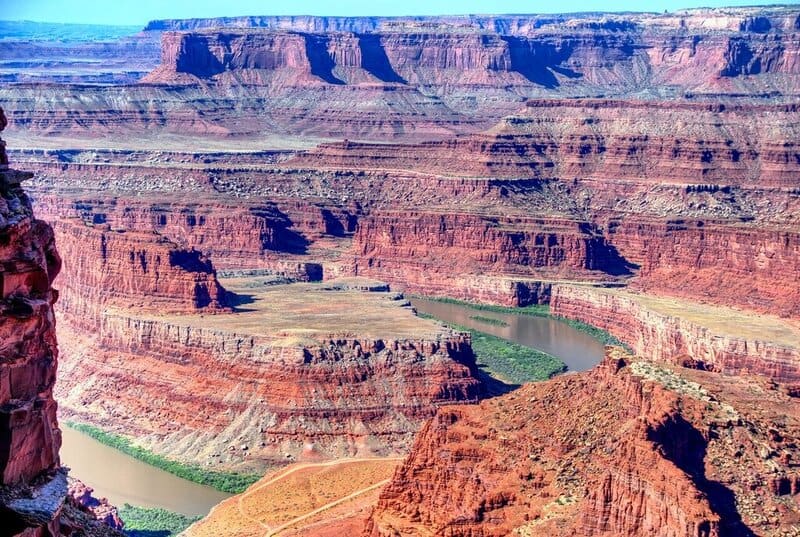
Last night in Moab. If you’re a fan of craft beer check out the Moab Brewery on the south side of town. The food is nothing to rave about, but decent pub fare for the middle of the desert.
Day 6: Moab to Monument Valley
Today is a choose your own adventure day. There is a lot of good stuff to see between Moab and Monument Valley and it depends on how ambitious you want to be. If you want to hit the Needles District of Canyonlands (the south unit), you’ll want to leave Moab before 7 AM. It’s about a 2-hour drive to the best part of the Needles District, and over an hour of that is off the highway – I.e. out of your way.
If you do go there though, you’ll be oohed and aahed by the needle-like rock formations. They are different from the hoodoos in Bryce Canyon, more pancake-like with different layers. This part of Canyonlands looks nothing like the Island in the Sky district you were at yesterday.
Valley of the Gods and Goosenecks State Park
If going out of the way like that is a bit too much then your first stop of the day will be Valley of the Gods, about 2.5 hours south of Moab between Bluff and Mexican Hat. Valley of the Gods is a small valley between high plateaus that has some buttes and other interesting rocks. It’s kind of like a baby Monument Valley.
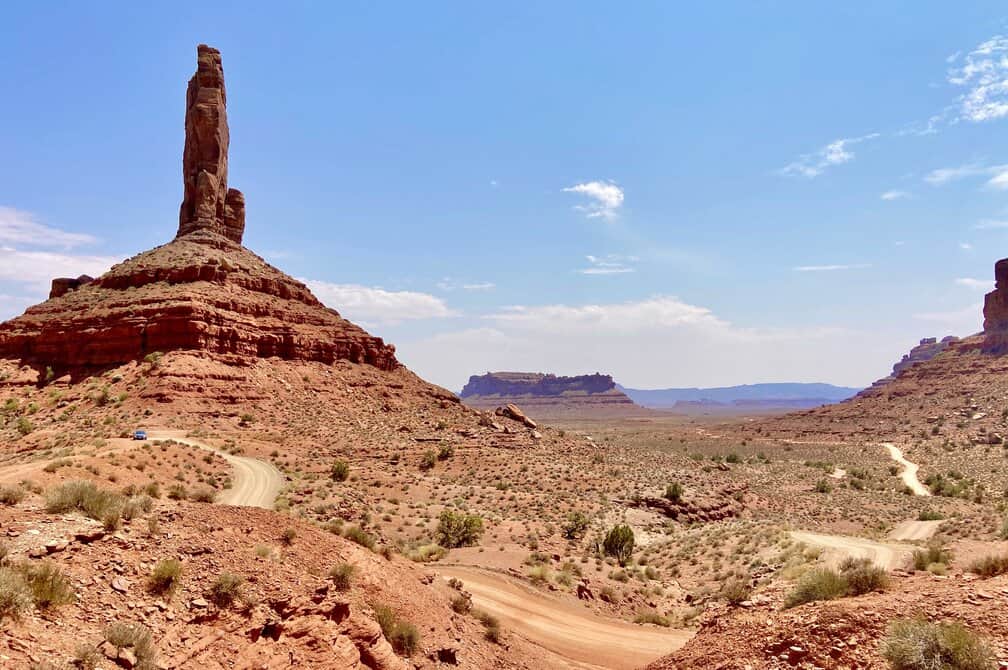
There’s a dirt road that forms a loop that spits you out on a side road. The drive will take you about an hour total, including stops. A 2WD drive vehicle is adequate, so long as you don’t mind the car getting a bit dirty. The best thing about Valley of the Gods is that it is not super popular so you will have some solitude.
Just south of Valley of the Gods you’ll stop by Goosenecks State Park. This is another Utah state park that is worth visiting just to look at the San Juan river “gooseneck” though the canyon. Visiting the park will take no more than a half hour and can literally be done in a few minutes. Admire the views from above the canyon, then continue your drive south.

Monument Valley
After you pass Mexican Hat, a town named after a rock that looks like a sombrero, you’re officially in Monument Valley, one of the most unique places on the planet. The region is essentially a relatively flat high desert with giant sandstone rock buttes that stick out of the desert floor.
For fans of the movie Forrest Gump, it’s important to stop by Forrest Gump Point to take a photo of yourself running on the road like Forrest did in the movie. From there you’ll head south into Oljato-Monument Valley, what can only be described as a tiny village of a few houses and a grocery store. You’re in Navajo Nation here, a sovereign Native American land.
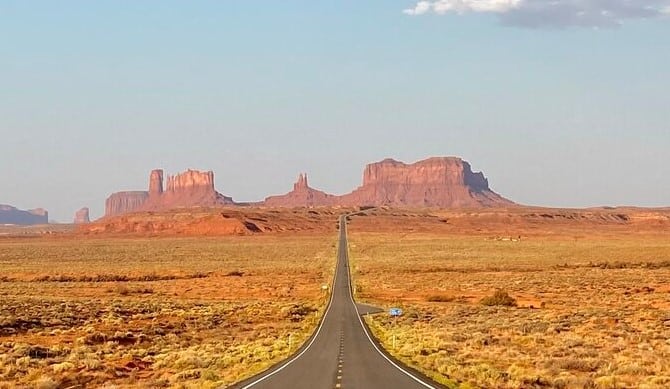
The Navajo Nation owns and operates Monument Valley Tribal Park, which is just across the state border in Arizona and contains the most spectacular collection of rock formations in Monument Valley. If you’re there early enough, hit the tribal park before the day is over. If not, you can do it in the morning before heading out.
There’s only one restaurant in Monument Valley and that’s the Stagecoach Restaurant at Goulding’s Lodge. Many accommodations will come with a kitchen for you to cook yourself though.
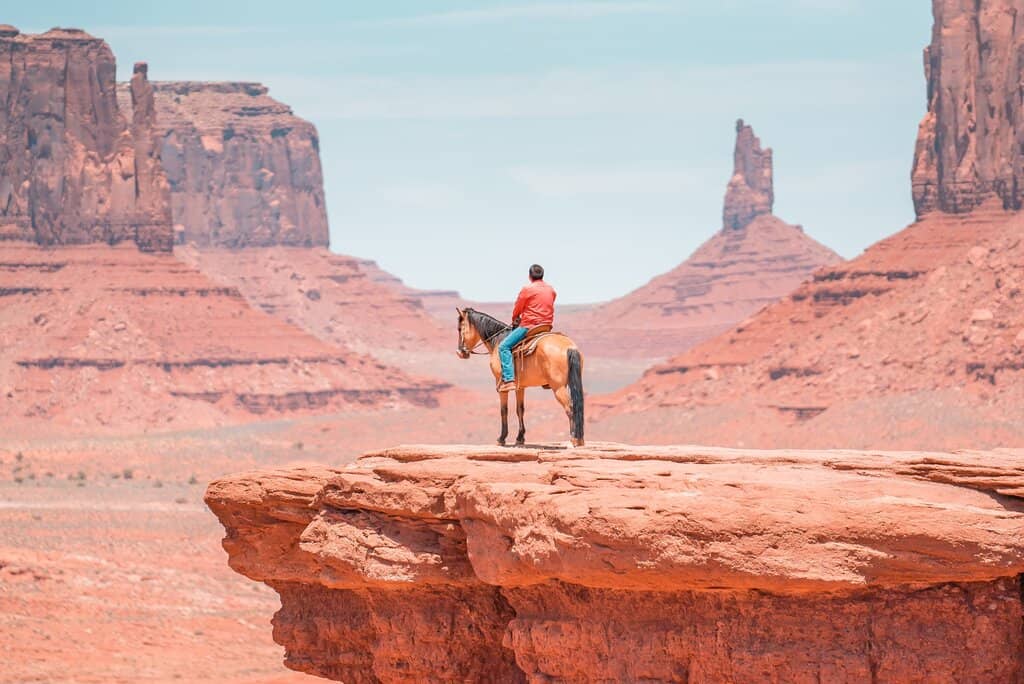
WHERE TO STAY IN MONUMENT VALLEY
Camping: Monument Valley KOA has plenty of sites for your camping needs. Tent sites are not cheap though, at about $60 per night per night. Goulding’s – the only hotel in town – also operates a campsite near their hotel.
Mid Range: There are only two hotels in town, Gouldings and The View Hotel, the latter which is run by the Navajo Nation at the entrance to Monument Valley Tribal Park. They are no frills accommodations, but they’re not exactly cheap.
High End: There are various other cabins and Airbnbs available in the region, but nothing really “luxury.”
Day 7: Monument Valley to Page, AZ
If you didn’t make it to Monument Valley Tribal Park yesterday, time to hit it this morning. If you did, then you can get going and head towards Page, Arizona, home to some of the most famous sites in the Southwest. You’ll actually be in Arizona all day today, so technically this road trip is not entirely in southern Utah.
It’s a two hour drive to Page, home to Antelope Canyon and Horseshoe Bend. Antelope Canyon is a narrow slot canyon with beautiful red colors that has become famous in the Instagram Age. In order to visit Antelope Canyon you must book an organized tour. It is not possible to visit on your own, as the Navajo Nation forbids that.
There are numerous tour operators and you can check out various Antelope Canyon tours on getyourguide here.
After lunch in Page, head to Horseshoe Bend just outside of town. Horseshoe Bend is one of the most iconic locations on the Colorado River and is located in Glen Canyon Recreation Area, which is managed by the National Park Service.
Your national park pass covers Glen Canyon, but the city of Page charges extra for parking at Horseshoe Bend. It’s only about a 20-minute walk from the parking lot to the canyon, so you don’t need too much time there. Horseshoe Bend is an amazing place to watch the sunset though, should you wish to come here for that instead.

With the rest of your afternoon you can check out Wahweap Bay in Glen Canyon National Recreation Area, though you probably won’t have time to get out on a boat. There are also some neat views of the Glen Canyon Dam on the bridge over the river. End the day with some excellent Mexican food at Fiesta Mexicana.
Where to stay in Page, AZ
Camping: There are numerous campsites in and around Page. Within Glen Canyon National Recreation Area the biggest campsite is Lake Powell Wahweap Marina RV Park and Campground.
Mid Range: There are plenty of mid-range hotels in Page, as the town is really catered to tourists. The Best Western View of Lake Powell is a good option, and where we stayed when we were in town.
High End: There is a Hyatt Place and a Courtyard by Marriott in Page, but nothing that is overly luxurious.
Day 8: Page to Zion National Park
Today you’ll head back into Utah to visit Zion National Park, one of the most beautiful places in the United States. It’s only about a 2.5 hour drive from Page, but you also have the option today to catch a glimpse of the Grand Canyon.
If you don’t think you’ll be coming back to the American Southwest any time soon, it’s worth it to add three hours onto your day to see the Grand Canyon.
The North Rim of the Grand Canyon is far less visited than the South Rim, where just about everyone goes. This makes it less crowded, but it’s also much less developed and there is only one viewpoint. It’s also closed yearly from Dec 1 to May 15, so don’t drive all the way there just for it to be closed.
If you choose the Grand Canyon option, you won’t get to Zion till late in the afternoon most likely. If you’re heading straight from Page, however, you can be there before lunch. With nearly two day in the park you’ll have sufficient time to explore the entire region and go on numerous hikes.
You’ll enter the park from the east entrance, which takes you on a stunning scenic drive through insane red, orange, and white rock formations. This is the only part of the park that you can drive yourself, with the exception of Kolob Canyons, which is a completely separate section of the park not connected by road to the main park.
The main park road is limited to the Zion shuttle service. You’ll park your car at the visitors center in Springdale and hop on the shuttle from there. It’s first come, first served, and on busy summer days you can expect to have to wait to board the shuttle.
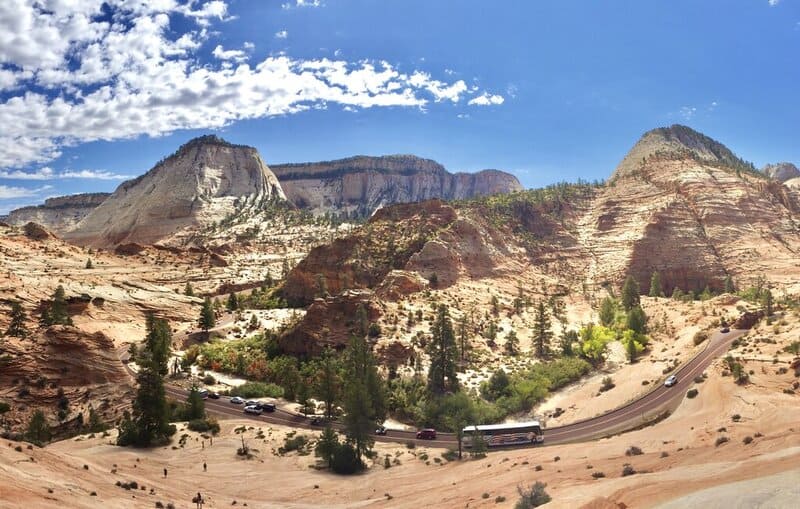
What to do in Zion
There are endless things to do in Zion National Park and we can’t describe them all in detail here. Spend the afternoon hitting some of the main spots on the Zion Canyon Road and stopping for a few short hikes. Some short hikes to consider:
- Zion Narrows Riverside Walk
- Emerald Pools Trail
- Lower Emerald Pools Trail
- Kayenta Trail
- Court of the Patriarchs
There are many other viewpoints you’ll see on the side of the road so it never hurts to hop off the shuttle and explore. For sunset, head to Zion Canyon Overlooks Trail on the road leading back to the east entrance. It’s only about a half mile to the viewpoint and it’s mostly flat.
Where to stay in Zion National Park
Camping: There are three designated campsites within Zion National Park. Reserve campsites well in advance.
Mid Range: There are mid-range holes in Springdale, UT, but they don’t have mid-range prices. Hope you don’t mind paying $300/night for a Holiday Inn Express. If that sounds crazy to you, check options in nearby Hurricane, UT.
High End: Unlike most of the other stops on this road trip, you can really live in luxury outside of Zion if you want to. Check out LaFave Luxury Rentals, the Cable Mountain Lodge, or the Cliffrose Springdale by Hilton.
Day 9: Zion National Park
Another day in Zion National Park. If you’re an avid hiker today is your day. And if you’re not an avid hiker, today is the day you become one. There are a few famous hikes in the park. The most notable is the Angels Landing hike, with the Zion Narrows hike being a close second. Both of these hikes require planning. Angels Landing requires permits, as it got so popular in recent years that it became unsafe.
Zion Narrows is a hike through a narrow gorge with thousand-foot cliffs on either side. The catch here is that most of the hike is on a riverbed and you’re pretty much guaranteed to get your feet wet at some point. It takes careful planning, as after heavy rains the water level can be too high.
If all that sounds a little daunting then you can opt for my personal favorite hike in the park: Observation Point. Unfortunately the main trail to Observation Point has been closed since 2019 due to a major rockfall.
To reach the viewpoint, you’ll have to drive about 45 minutes to the East Mesa Trailhead and hike about 9 miles round trip from there. It’s worth it, though. The view from up Observation Point is the best view in Utah.

Your big hike will take up most of the day. Spend the rest of your day stopping at any other viewpoints you want to hit. If a big, strenuous hike doesn’t sound too appealing after a week of desert hiking, consider checking out the other region of Zion, Kolob Canyons, which is about an hour drive from Springdale.
Day 10: Zion to Las Vegas
The final day of the road trip. You’ve seen plenty of Zion National Park and now it’s time to head back to Las Vegas. It’s only about a 2.5 hour drive back to Vegas, but you’ll be stopping in Nevada’s Valley of Fire State Park along the way.
Valley of Fire is one of the most underrated places in the desert Southwest. The park contains a collection of unique sandstone rock formations. By now you’ve seen a ton of red rocks, but Valley of Fire is special.
While it is certainly loaded with fabulous red rocks, the park contains some of the most colorful sandstone rocks you’ll ever see. Shades of pink, purple, yellow, green, and white rocks dot the landscape. It’s something that you really have to see to believe.
Spend a solid 4-5 hours in Valley of Fire, stopping at all the viewpoints and doing a few short walks. The best hike in the park is the White Domes Fire Wave trail at the end of the park road. This hike covers about 3 miles through slot canyons and over the colorful rocks I just mentioned. The trail is a bit hard to follow so it’s useful to have AllTrails or Maps.me loaded on your phone for the hike.
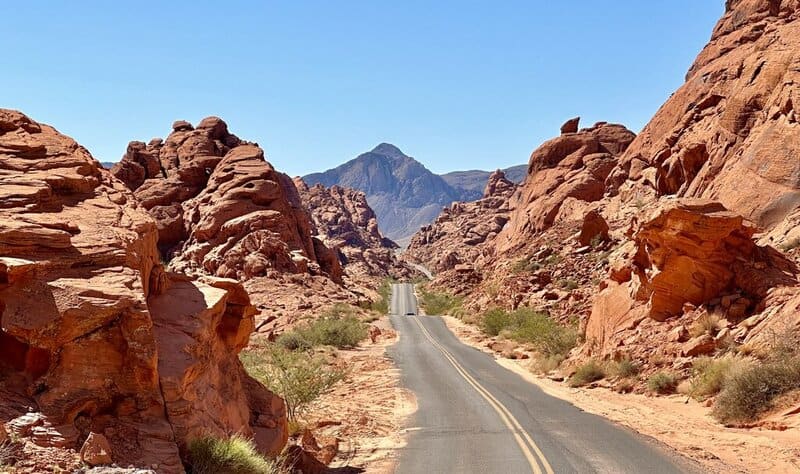
Before leaving, be sure to stop at this spot along Mouse Tank Road for the most famous mountain view in Nevada. The road winding through the red rock cliffs with the mountains in the background is truly a sight to behold! From the viewpoint it’s about a 75-minute drive back to Las Vegas, where you can indulge in whatever sort of debauchery your heart desires to celebrate an amazing road trip through southern Utah!
You can read more about Valley of Fire in my guide to the natural side of Las Vegas here.
If you have more time in Vegas consider adding on a day trip to Death Valley National Park in Southern California. Death Valley is a whole different landscape than you’ll see in Utah and one of the most underrated national parks in the US. It’s a 2 hour drive from Las Vegas and east to see the highlights in one day.
Southern Utah Road Trip: FAQs
What is the best time of year to visit southern Utah?
The best time of year to visit southern Utah is either spring or fall. This allows for pleasant days while avoiding the summer heat and crowds. Winter can be nice too, but the Moab Desert is often covered in snow and higher elevation places like Bryce Canyon can be difficult to access due to heavy snowfall.
What is the prettiest area of Utah?
The prettiest area of Utah is open to interpretation and could be just about anywhere! The entire state is stunning, from the alpine mountains in the north to the Moab Desert in the south. For many people, the uniqueness of the landscapes in the national parks like Zion and Arches make those the prettiest.
What is the most beautiful park in Utah?
The most beautiful part in Utah from top to bottom is open to debate. Most consider either Zion or Bryce Canyon the most beautiful parks, with Arches and Canyonlands trailing close behind. Capitol Reef is often the afterthought, though in any other state it would be possibly the most beautiful place in the state.
Should I go on a road trip through Utah?
Yes, you absolutely should go on a road trip through Utah! From top to bottom Utah is one of the most, if not the most, beautiful states in the United States and features some of the most impressive and unique landscapes on the planet. Anyone who loves nature and the outdoors will love Utah.
How to see all 5 national parks in Utah?
The easiest way to see all 5 of Utah’s national parks is to drive between them. The closest major airports are Las Vegas or Salt Lake City. Though it’s also possible from Phoenix and a few other smaller regional airports in Utah, Colorado, and Arizona.
Southern Utah Road Trip: The End
That was an epic trip, wasn’t it? You’ve seen the very best that the southwestern United States has to offer on this epic southern Utah road trip. The only downside of this trip is that you’re going to have such an amazing time that returning to your everyday life might be too difficult to handle!

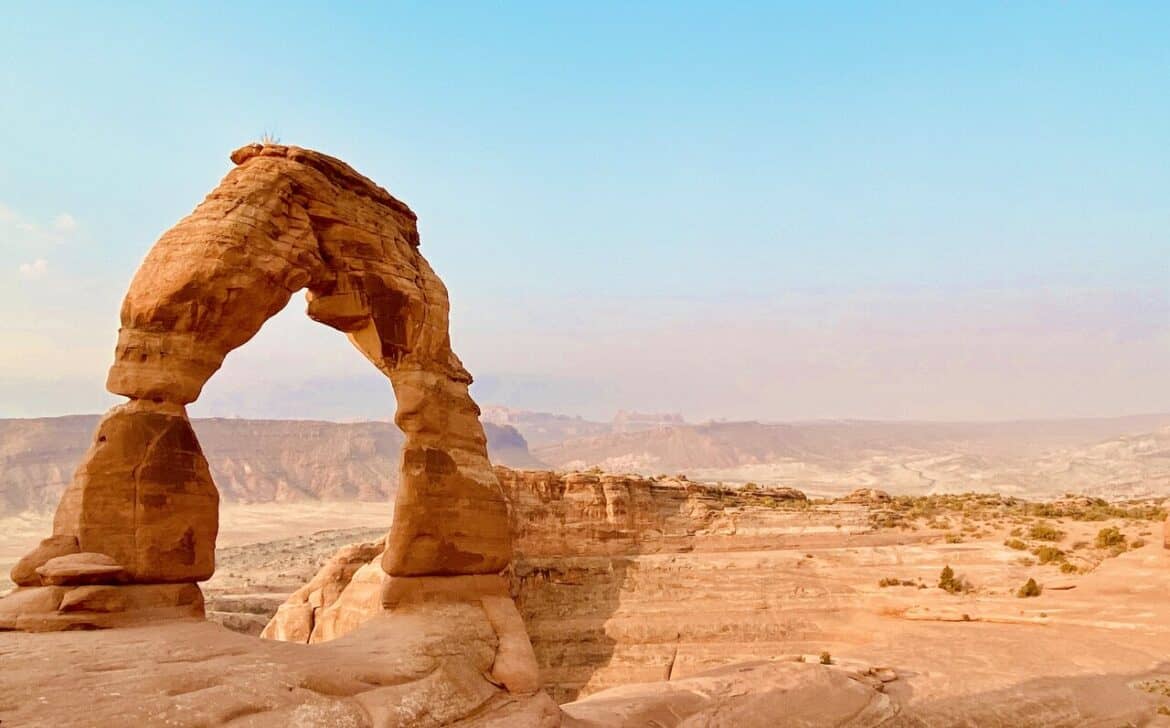
2 comments
Incredible article with all the details I was seeking for planning our trip to Utah from Canada. I can’t thank you enough sharing! We’ve been wondering about driving or camping, where to start, what’s the best stops, etc. and you covered it all. Amazing!
Thanks Candice! Hope you guys enjoy Utah, it really is the best. Feel free to contact me if you have more questions.